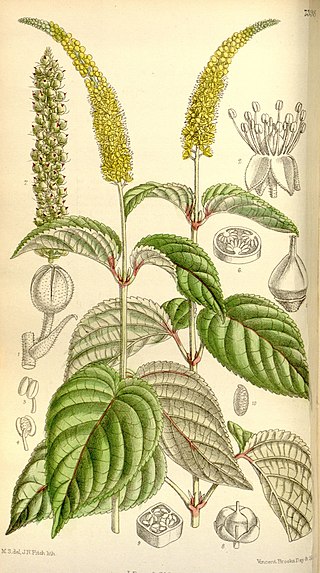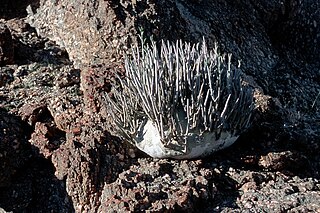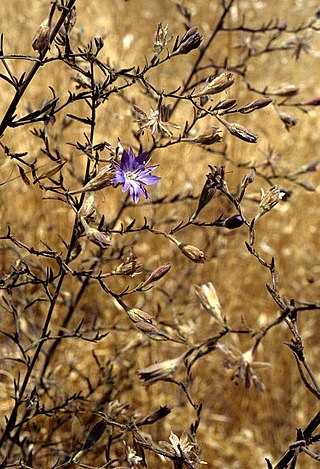
Liberia, officially the Republic of Liberia, is a country on the West African coast. It is bordered by Sierra Leone to its northwest, Guinea to its north, Ivory Coast to its east, and the Atlantic Ocean to its south and southwest. It has a population of around 5 million and covers an area of 43,000 square miles (111,369 km2). The country's official language is English; however, over 20 indigenous languages are spoken, reflecting the country's ethnic and cultural diversity. The capital and largest city is Monrovia.

Passiflora, known also as the passion flowers or passion vines, is a genus of about 550 species of flowering plants, the type genus of the family Passifloraceae.

The Passifloraceae are a family of flowering plants, containing about 750 species classified in around 27 genera.

Abatia is a genus of about ten species of Central and South American trees in the family Salicaceae. Previously, it was treated in the family Flacourtiaceae, or tribe Abatieae of the family Passifloraceae or Samydaceae by G. Bentham & J.D. Hooker and Hutchinson.

Adenia is a genus of flowering plants in the passionflower family Passifloraceae. It is distributed in the Old World tropics and subtropics. The centers of diversity are in Madagascar, eastern and western tropical Africa, and Southeast Asia. The genus name Adenia comes from "aden", reported as the Arabic name for the plant by Peter Forsskål, the author of the genus.

Malesherbia is a genus of flowering plants consisting of 25 species in the Passifloraceae. This is a xerophytic group endemic to the Peruvian and Chilean deserts and adjacent Argentina. The genus is currently recognized by the APG III system of classification in the family Passifloraceae, and is the sole member of the subfamily Malesherbioideae.

Otto Stapf FRS was an Austrian born botanist and taxonomist, the son of Joseph Stapf, who worked in the Hallstatt salt-mines. He grew up in Hallstatt and later published about the archaeological plant remains from the Late Bronze- and Iron Age mines that had been uncovered by his father.

Cordylanthus, commonly known as bird's beaks, is a genus of parasitic plants in the broomrape family, Orobanchaceae. These western North American natives are sparse, weedy-looking annuals with long branching erect stems and little foliage, and many bear bird's-beak–shaped flowers. They are remarkable among the broomrapes for growing at searing temperatures in arid climates.

Chloropyron palmatum is an endangered species of salt-tolerant, flowering plant in the family Orobanchaceae. It is a low, highly branched herbaceous annual with each flower enclosed by a single, characteristically palmate bract. It is known by the common names of palmate salty bird's-beak and palmate-bract bird's-beak.

The genus Barteria is in the family Passifloraceae in the major group angiosperms. It contains 8 described species, however, only 6 are accepted.

Chloropyron is a genus of plants in the botanical family Orobanchaceae. The plants of this group were formerly classified in the subgenus Hemistegia of the genus Cordylanthus, but were elevated to genus level by David C. Tank, John Mark Egger and Richard G. Olmstead in 2009 after molecular phylogenetic work.

Tricliceras is a genus of flowering plants belonging to the family Passifloraceae. Its native range is Tropical Africa, Southern Africa, Madagascar.
Viridivia is a monotypic genus of flowering plants belonging to the family Passifloraceae. It only contain one known species, Viridivia suberosa. It is also in the subfamily Passifloroideae and tribe Paropsieae.
Paropsiopsis is a genus of flowering plants belonging to the family Passifloraceae.

Afroqueta is a genus of flowering plants belonging to Turneroideae (Passifloraceae). It is a monotypic group, consisting of Afroqueta capensis(Harv.) Thulin & Razafim.

Streptopetalum is a genus of flowering plants belonging to the family Passifloraceae.
Schlechterina is a monotypic genus of flowering plants belonging to the family Passifloraceae. The only knowns species is Schlechterina mitostemmatoides.
Malesherbia laraosensis is a member of Malesherbia (Passifloraceae) described in 2014 by Hamilton Beltran and Maximilian Weigend. It is the only member of the genus known to inhabit Laraos, Peru. It is described as a small shrub, with branch lengths up to 15 cm long, these features make it morphologically distinct from other Peruvian members of the genus. It has orange flowers with red tips, and flowers from May - July.

Oxossia is a genus of flowering plants in the subfamily Turneroideae (Passifloraceae) consisting of 15 species. This genus was recently defined in 2019 after a phylogenetic analysis of Turnera justified the creation of the genus. The genus is characterized by its stipules, small flowers, congested inflorescences, "hairy" stamen and style, and the attachment of stamen to the floral tube. All members of the genus are heterostylous with the exception of O. dasystyla. The genus can be divided into two morphological groups: those with white petals and those with yellow pink or red petals.
Malesherbia lirana is a perennial herb whose native range is from Argentina and Chile. The species has racemose inflorescences that are 2 - 3.9 cm in size and cream colored petals. It flowers in spring to late summer.














